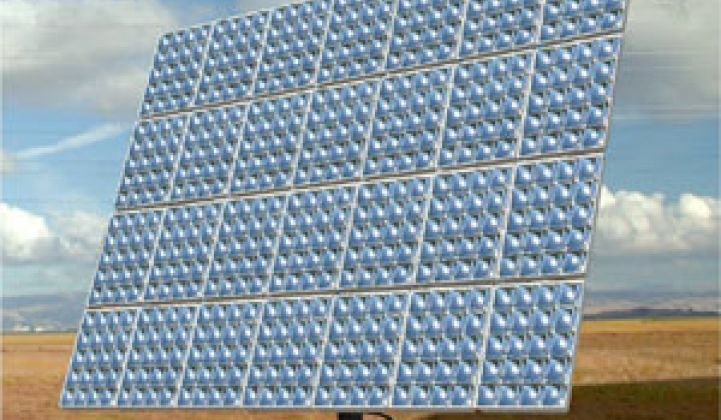SolFocus unwrapped its new concentrating solar energy system Thursday. Its second commercial product can now convert 25 percent of the sunlight that hits its cells into electricity.
The Mountain View, Calif.-based startup improved the efficiency – a leap from the 18 percent reached by its first commercial system launched a year ago – largely by redesigning the optical components, said Nancy Hartsoch, vice president of marketing for SolFocus.
A SolFocus system is composed of a giant panel mounted on a tracker that tilts the panel to follow the sun's movement. On the panel are rows of curved mirrors that can concentrate 500 times the sunlight onto optical rods, which then lead the light into solar cells made with germanium substrate and gallium-arsenide and other compounds in the same class of semiconductors (III-V).
Gallium-arsenide cells are much more efficient than conventional, silicon-based cells that are found in most panels on rooftops and the ground today. Some super-efficient cells on the market today can reach 40 percent efficiency, but are not in high-volume production, Hartsoch said. A leader in silicon-based cell maker, SunPower, has been making cells with 22 percent efficiency.
Gallium-arsenide cells also are much more expensive and have historically been used for panels mounted on satellites (see a list of gallium-arsenide cell makers).
Those expensive cells are slowly finding their way to solar energy systems on Earth. Not all concentrating photovoltaic companies use gallium-arsenide cells, but those that do are gradually finding more buyers for their systems. The Spanish market has embraced these systems earlier than other markets, including those made by SolFocus (see SolFocus Completes Spanish Project, Eyes California).
SolFocus buys solar cells from other companies, such as Spectrolab and Emcore, and assembles them into panel-and-tracker systems.
One of the first customers to use SolFocus' new system will be EMPE Solar, which plans to build 10-megawatts worth of projects in different sites across southern Spain by the end of 2010. SolFocus plans to begin working on the $103 million (€80 million) project in early 2009 and delivering the systems in mid-2009, Hartsoch said.
Hartsoch declined to disclose the manufacturing cost or the selling price for the new system.
The company's first commercial installation in the United States, located at one of the transmitters of the San Francisco-based radio station KGO, went online last month (see SolFocus Turns On First U.S. Commercial Installation).
SolFocus, founded in 2005, expects to see a half-megawatt worth of its systems installed by customers before the end of 2008. The company hopes to install 10 megawatts to 15 megawatts of systems in 2009 and 85 megawatts in 2010, Hartsoch said.
Concentrating photovoltaic systems work best under constant hot sun, so the American southwest will make ideal locations for them.
Join industry leaders and influencers at Greentech Media's new conference series Greentech Innovations: End-to-End Electricity on November 17 and 18 in New York City.



